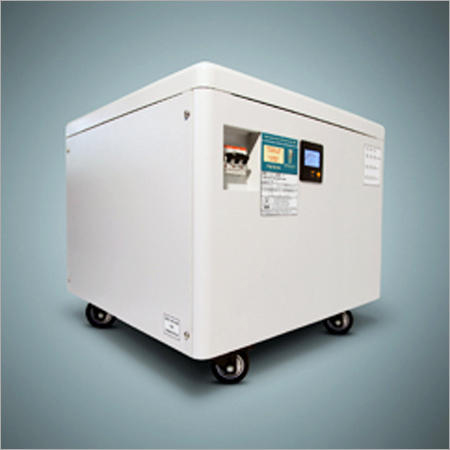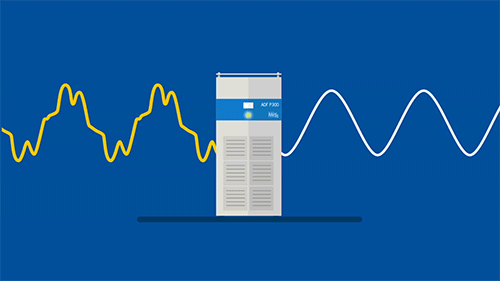Static Voltage Regulator

The static voltage regulators serve as ideal solution for situations where stable power is mandatory, esp. for high end electronics. These static voltage regulators incorporate TSi’s unique pulse-width-modulation technology.
The high frequency insulated gate bi-polar transistor (IGBT) driven converter takes the incoming AC power, measures against the nominal voltage and adds or subtracts voltage, 20,000 times per second, to achieve precisely regulated 230 VAC output on real-time basis.
The automatic bypass will be activated when there is a fault condition. Green LEDs are used to indicate Normal (regulating mode) operation.
The PMW technology based static voltage regulators allow trouble free operation of your electronic equipment over a wide AC input voltage range. They can handle any nature of load, resistive, inductive or regenerative, with equal ease. Furthermore, there is no switching of taps or otherwise a break in the power path, which ensures continuous, uninterrupted power supply to the load, irrespective of input voltage variations.
These static voltage regulators are plug & play type, easy to install and are light in weight. They are available for indoor installation as well as outdoor installations.
Applications of Static Voltage Regulators
Our technology is ideally suited for high-end applications where high quality AC power is absolutely necessary, and where conventional methods like servo voltage stabilizer or switching relay stabilizer fail, such as
CNC machines
Industrial process control, Automation & Robotics
Automated Petrol Pumps & Dispensers
Banks, ATM’s
IT, ITES & Data Centers
Printing Machines
Mobile communications (MSC/ BTS sites)
Radio base stations / TV broadcasting
Radar & Microwave Stations
Laboratory or Analytical Measurement Equipment
Medical, Diagnostic & Hospital equipment
Security, Screening & X -Ray Machines
Malls, Multiplexes, showrooms, villas, Residential & Commercial establishments
Major Difference between Servo Stabilizer & Static Stabilizer
Voltage correction
Instant, Real time and precision Voltage correction is better with Static Stabilizer
Power Quality
Sag elimination, Surge and Spike supression
Reliability
The servo voltage stabilizer achieves correction in the voltage load by increasing or decreasing the number winding in the auto transformer with the help of the shaft of the servo motor. This results in increase or decrease of the voltage across the primary of the Buck or Boost transformer in place of the Buck or Boost transformer thereby correcting the output voltage. Therefore the reliability of the servo voltage regulators mainly depends on the reliability of the servo motor. Similarly, the reliability of the static voltage stabilizer depends on the reliability of the IGBT power stage. But if we do a general comparison the static IGBT power stage has proved to be more reliable than the electromechanical servo motor, thus the SVS is more reliable than the servo stabilizer.
Correction Time and Speed
As the Static Voltage stabilizer does not have any moving part, it has a pure electric circuit to achieve the corrections in voltages. Thus, the static stabilizer has an extremely low correction time of 20millisecond and an exceptionally high voltage correction speed ranging from 360 to 500 V/ sec.
On the other hand, the Servo Stabilizer uses a moving servo motor controlled stabilization system, which helps it to achieve correction in the voltage. The servo stabilizer is an electromechanical device, thus its voltage correction speed (100 V/ sec) is slower than that of static voltage stabilizer while its servo stabilizer correction time is of 50 milliseconds to 5 seconds.
Level of Protection from short circuit:
There is no doubt that while a stabilizer controls voltage fluctuations it should also provide protection to the heavy machinery from under and over current faults that result from short circuits. The DSP control board present in the static voltage stabilizer continuously senses the input voltage; the output voltage, the IGBT current and the load current as part of its working principle. When a short circuit happens at the output of static voltage stabilizer, the load current increases to an extremely high level which automatically gets sensed by the DSP controller which makes it cut the output and switches of IGBT power stage- this is done instantly to clear over current fault. Therefore, the over current fault gets clear in the SVS extremely quickly and without the need to add any extra hardware. But in the case of servo stabilizer, the over current protection can be achieved only with the help of extra hardware such as MCCB, CB etc.- but this process of clearing faults is not instant.
Maintenance
As we already know that the servo stabilizer functions with the help of a motor and having a motor will regularly result in wear and tear which needs frequent maintenance. On the other hand the Static voltage stabilizer is static in nature and does not require regular maintenance.
Auto Bypass Facility
The auto bypass in a static voltage stabilizer is very easy, due to the fast electronic nature of the SVS, it can transfer to bypass automatically without any break in the output voltage (Zero Transition Time), even in case of a fault. While the servo stabilizer is complicated in making the auto bypass mechanism work, due to this complication even if it is provided, the whole process becomes very costly. Also even if it this mechanism is provided it will be with break in the output voltage that is it will need a transition time.
Thus, we conclude that Static Voltage Stabilizer (SVS) provided by a leading Servo stabilizer manufacturer in India, Servo Star is a newer replacement to the traditional Servo Stabilizer.
